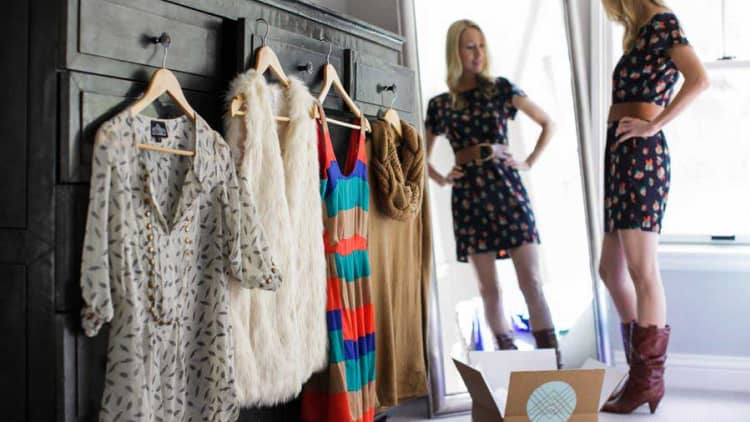
Online styling service Stitch Fix's shares plunged more than 10 percent after it reported its first earnings as a publicly traded company Tuesday afternoon.
While earnings and sales just slightly surpassed analysts' expectations, gross margins were hampered by investments into new categories, falling nearly 3 percentage points. In the near term, Stitch Fix said it continues to expect profit margins to decline as those investments ramp up.
On a call with analysts and investors, CEO Katrina Lake said Stitch Fix plans to grow with existing clients in its core women's business, and the company aims to acquire new customers as marketing efforts are accelerated.
Here's what Stitch Fix reported, compared with what analysts surveyed by Thomson Reuters were expecting:
- Earnings of 4 cents a share, compared with a forecast of 3 cents per share.
- Revenue was $296 million, versus an estimate of $295 million.
The company said its number of active clients in the first quarter mushroomed to 2.4 million users, up nearly 30 percent from a year ago. An active client, according to Stitch Fix, is one who "checked out a Fix" in the preceding 12-month period, indicating which fashion items he or she is keeping either through the mobile app or website.
Total sales climbed 25 percent, to $296 million, boosted by growth in the company's recently launched men's and plus categories. In the women's category, Stitch Fix has been adding new price points, including a premium line and more lower-priced options.
Net income for the fiscal first quarter was $13.5 million, or 4 cents a share, compared with earnings of $13.2 million, or 14 cents per share, one year ago.
Excluding the one-time impact of a revaluation of its preferred stock options, Stitch Fix said it earned $4.4 million on a non-GAAP basis.
Looking ahead, Stitch Fix said it expects to post sales between $287 million and $294 million in the second quarter, and fiscal 2018 revenue could be as much as $1.22 billion.
"Seasonality in our business does not follow that of traditional retailers, such as typical concentration of revenue in the holiday quarter," the company added in a statement.
Stitch Fix also said its margins were hurt by "higher shrink," which in the retail world refers to loss of inventory attributed to factors such as employee theft, shoplifting, damage in transit or cashier errors.
The company said in a statement Tuesday: "We are actively working on various strategies to reduce shrink, including using technology to help manage client behavior and improve our carrier claims process."
Just last month, San Francisco-based Stitch Fix raised $120 million in a downsized IPO that priced below its indicated range of $18 to $20. The stock, which began trading on Nov. 17, has wavered ever since, with investors wary of Blue Apron's and Snap's not-so-successful public offerings, leaving a cloud hanging over the start-up industry.
Against a backdrop of consumers rapidly changing their preferences for apparel and other fashion accessories, Stitch Fix hopes its more personalized online service will appeal to a broader swath of people.
"Stitch Fix is revolutionizing fashion through direct shipments of apparel that has been selected through the combination of data science and personal stylists," RBC Capital Markets analyst Mark Mahaney wrote in a recent note to clients.
"We believe if the company executes well and ramps their category expansion, they should be able to at least double that [active client] figure to 4 [million] over the next 3 years," Mahaney added.
Using the Stitch Fix platform, customers submit size, budget and style preferences before receiving a box of five apparel and accessories items, which can either be purchased or returned. This model can be attractive because companies can forecast revenue streams, but many have struggled to balance those sales against steep marketing costs.


